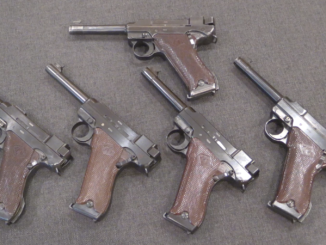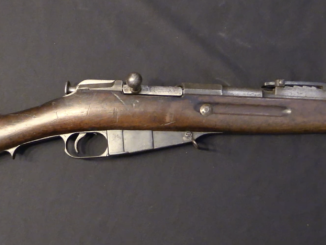The basic equipment of the Finnish Army came from what was left in Finland by departing Russian soldiers when Finland declared independence. As the Russians had no scoped rifles at that time, Finland didn’t have any either. The Finnish Army began experimenting slowly with the concept of a scoped military sniper in the 1920s, but really didn’t do anything. The Civil Guard made a few dozen experimental snipers in the 1920s and 30s, but also nothing of real significance.
In 1936, the Army finally made a concrete move, contracting to purchase 250 3x optical sights from Physica Oy in Helsinki. These were intended to be universal optics, suited for mounting on sniper rifles, machine guns, and small cannon – an idea that looks great on paper but is actually terrible. By the time the Winter War began, only 84 of the scopes had been received. Ultimately, 150 of the scopes were assembled onto M27 pattern sniper rifles, with the remaining 100 scopes put into storage (none would ever actually be used on machine guns or cannon). The scope had a number of problems; it was heavy, awkward to use, had very short eye relief, and tended to fog up in cold weather.
When the Continuation War began, the M39 had replaced the M27 as the standard Army rifle. The M27 PH snipers were mostly torn down, and the scopes were mostly used to assemble new M39 PH rifles. These had largely the same problems that the M27s had, and they were not particularly popular arms during the war.
In addition to the M39 PH, Finland also built a number of M39 SOV snipers using capture PE and PEM Russian scopes, a few hundred M39-43 snipers with German Ajack 4x scopes, and a few hundred M39-44 snipers with a domestic Finnish copy of the Ajack. None would be of real significance during World War Two, with the M39-44s not even completed until after the war was over for Finland.




Got a question….It appears that the sight is not in a direct line with the barrel of the rifle. Therefore, how do you line up for an accurate shot? I mean, won’t the bullet impact point be offset from where the barrel is pointed? Thanks.
Yes the point of impact would be a couple of inches to the left of the point of aim. If well regulated the line of sight would be parallel to the line of travel of the bullet as far as windage is concerned so this is not really a big problem and this approach of an offset scope is perhaps more common than you might think at first. For example the M1C and M1D (Grand) sniper rifles: https://www.snipercentral.com/us-m1c-m1d/ and all sighting systems for the Bren, the Japanese Type 96 machine-gun, etc. (top-mounted magazines so sights are offset) etc.
The bolt handle seems longer, as well as bent. Making new bolts would have been an extra investment.
…I wonder if the 1939 Polish Army was the only 1 million+ army in the world which did not endorse the scoped rifles? (despite plenty of surplus from the partitioning powers + the French + all other sources stashed in arsenals).
It’s interesting that the mounting dovetail appears to taper both top and bottom
Is there a special reason for this?
Both angles look too steep for one of the angles to create a specific convergence between the optical axis of the scope and the bore axis in the vertical plane.
Or was this part of a “cunning plan”?
Was the centre line of the dovetail on the scope actually parallel with the optical axis +/- a specified additional angle?
“…If well regulated the line of sight would be parallel to the line of travel of the bullet…”(С)
Don’t make up nonsense.
“line of sight” happens to be “parallel to the line of travel of the bullet” many times during the flight of the bullet to the target, but “well regulated” is not possible.
The maximum that can be done is to parallelize the line of sight with the throwing plane. But this doesn’t make much sense because of the derivation.
The only thing that makes sense is the alignment of the center of hits with the aiming point. And in order for this to occur at different distances, the operator of the device must be able to count (at least on the fingers) and have at least primary knowledge of applied ballistics.
But not trying to “well regulated the line of sight would be parallel to the line of travel of the bullet”. 😉
PS “Stupidity, uttered with a clever expression, does not turn into wisdom.” (C)
“Fools should be seen and not heard if they wish to no longer be fools.”
Hm. A “general purpose” scope. Only state officials can come up with this kinda idea. Well, at least it wasn’t supposed to be “also suitable” for mortars, pistols and crossbows…